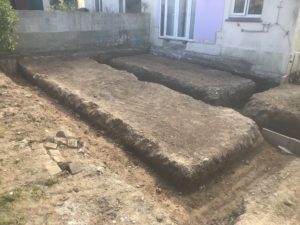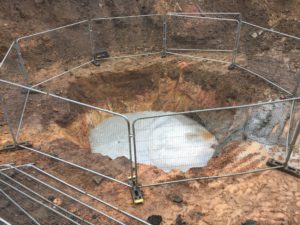Going deeper: Groundsure’s mine cavity remediation approach
Groundsure’s latest blog looks at Cornwall’s metalliferous mining and an example of its mining searches, entitled Going deeper: Groundsure’s mine cavity remediation approach.
Cornwall has a long and illustrious history of metalliferous mining stretching back for centuries until the last Cornish tin mine at South Crofty closed in March 1998. While it came to an end, its legacy is still being felt today. Prior to regulations being brought in to ensure safe building practices on Brownfield sites affected by mining, a large number of properties were built on previously mined ground which has left them at risk of settlement or subsidence.
Groundsure’s expert mining geology team is regularly required to carry out detailed mining searches and where necessary appropriate site investigations to clarify the risks to properties in areas with a past history of mining activity.
St Ives and Carbis Bay are now known as bustling seaside holiday towns which are frequented by many tourists every year and more recently as host for the G7 Summit. However, the area was heavily mined for tin, copper and other metals at its peak through the 18th and 19th centuries. Unlike other Cornish Mining towns, such as Camborne or Redruth, there is very little lasting evidence of their legacy. Most of the mining features are now backfilled and have no surface expression, until settlement or subsidence occurs.
As with most property sales in Cornwall, we undertook a desktop mining search on the subject property in Carbis Bay, which highlighted a risk from potential mining features from records including OS maps, our own archive of Private Mine Plans and site investigation records previously carried out in the local area. It was recommended that an intrusive site investigation was carried out to fully assess the mining risk to the property.
The Investigation
The property lay within the boundary of an area identified as having past metalliferous mining. The desktop search revealed records of a mine shaft, poorly documented mineralised veins and both mine waste tips on site and suspect areas of wasteland, which can be indicators of underlying mining features. The combination suggested that the property was at risk from mining related settlement or subsidence.
One of the major benefits of the Groundsure Geology Team is our in-house site investigators: expert geotechnical and geological engineers who interpret the desktop report with what they see on (and indeed) below ground.
The site investigation was carried out using down-the-hole type hammer percussion drilling, using a 100mm diameter bit and a compressor. The compressed air returned the drill flush material to the surface, and this was examined and interpreted by our team.
This method of drilling is suitable for the identification of surface and near surface mining features, areas of voids or suspect soft, natural or man-made ground conditions. The fine dust and chippings returned back up the hole is used to assess ground composition combined with drilling rate (progress is fast through voids and fill material) to provide a reasonable interpretation of ground conditions encountered.

Example of a foundation investigation by the Groundsure team at a residential property
Identifying Sub-surface Features
The investigation covered the footprint of the building within the property, as well as the additional mining features shown on the desktop search. During the investigation two significant features were found and documented. This included the expected shaft which was found to lie wholly within the property.
The shaft was beneath a small, single block outbuilding which was showing signs of settlement, indicated by cracks in the walls and deformation of the floor slab. Additionally, a surface working with an apparent natural base was found in the western part of the property and lay partially under the footprint of the dwelling. Our site investigation report concluded that to mitigate the ongoing risk to the structures, appropriate securing works were necessary.
The Remediation Solution
The shaft was close to the site boundary, so an additional trench was excavated to understand the quality of ground around the shaft and to ensure securing works could be carried out safely, without disturbing the nearby road. Once the ground conditions were confirmed, we supervised the excavation and securing of the mine shaft using a mass concrete plug specifically designed to provide a long term solution to remove the risk of further settlement or subsidence.
Securing mine workings in this way will allow future development of the site. Following the remedial works the risk from the shaft had been mitigated and the records are held so that when the property came back on the market, buyers would be reassured that any concerns raised from the mapped shaft have been professionally addressed.
The loose backfill material was excavated from the full extent of surface working identified by the drilling exercise to prove a natural undisturbed base. The structure was then underpinned to remove the risk of settlement related damage where the feature passed beneath the foundation of the dwelling.

Example of mining remediation by the Groundsure team
Keeping Transactions Moving (and not the Ground)
The combined expertise of our mining geology data, map archive and site investigation team provides a unique combination for assessing and mitigating past mining risk for property owners and potential buyers.
Our team was able to confirm that the site was now free from mining related settlement or subsidence. The client was left reassured, with a property that was suitable for mortgage and insurance purposes.
So, it shouldn’t spell disaster if a search uncovers past non-coal mining activity. Conveyancers can have the answers to all mining data in England and Wales through Groundsure’s Avista report or through a bespoke Desktop Mining Report, backed up by expert interpretation and, as needed, site investigation and remediation. This end to end solution ensures your client’s property transaction keeps moving and delivers peace of mind for future owners to come.
For more information on Groundsure’s range of mining searches and Site Investigation Services, visit www.groundsure.com/mining, email [email protected] or call 01273 257 755.
Kindly shared by Groundsure


















